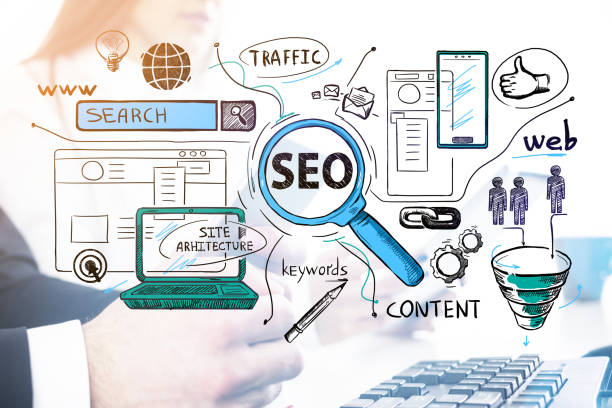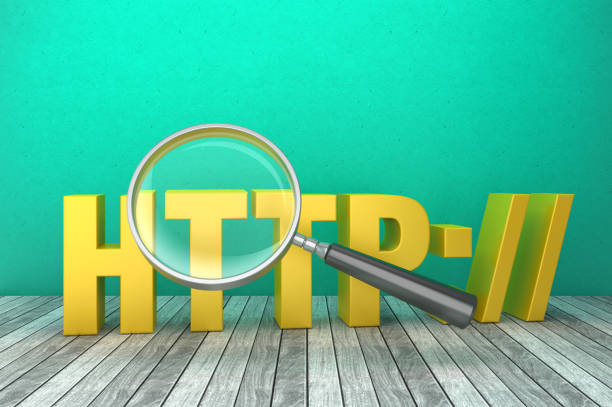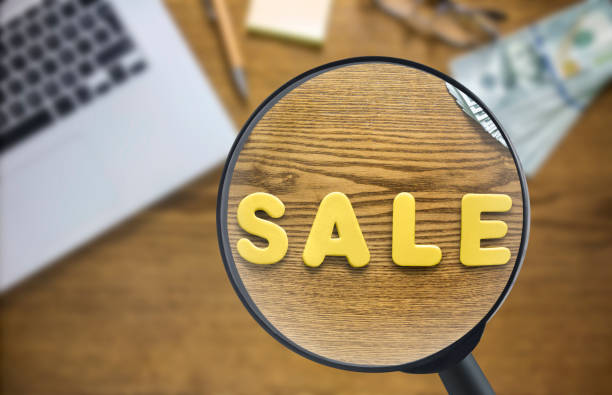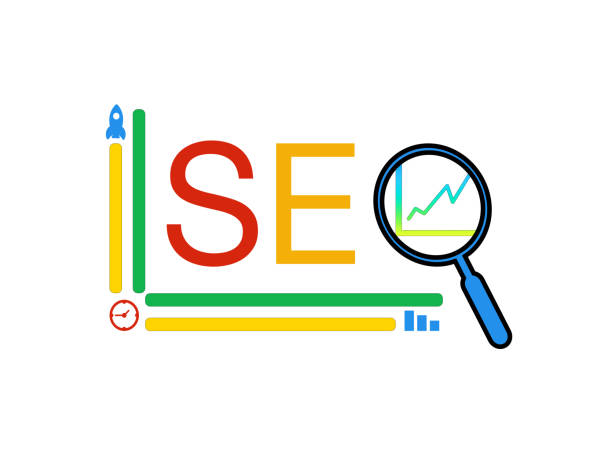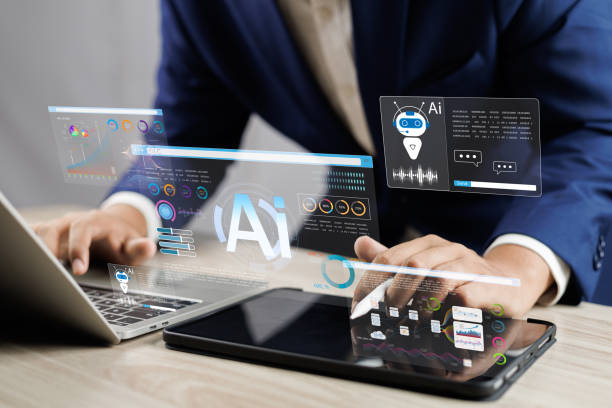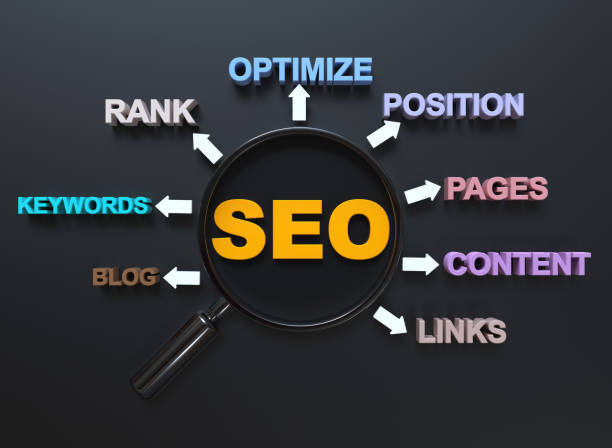An Introduction to On-Page SEO and Its Importance in Ranking
#On-Page SEO#, or On-Page SEO, refers to a set of #optimization actions# performed within the website itself to improve its ranking in search engine results.
This includes optimizing content, site structure, and HTML codes.
In fact, On-Page SEO is considered the #foundation# of any successful SEO strategy, because through these on-site optimizations, search engines can better understand your content and assess its value for users.
From an educational perspective, it can be said that without strong On-Page SEO, even the best content might get lost among the vast amount of information on the internet.
The importance of this approach lies in having complete control over it and being able to directly influence the improvement of user experience and ultimately your site’s ranking.
This process includes factors such as keywords, URL structure, title tags, meta descriptions, and even image optimization.
A deep understanding of On-Page SEO not only helps you attract more organic traffic but also leads more targeted visitors to your site, resulting in higher conversion rates.
As a general explanation, On-Page SEO can be said to be a bridge between your content and search engines.
Do visitors leave your e-commerce site before purchasing? Don’t worry anymore! With Rasaweb’s professional e-commerce website design services, solve the problem of converting visitors into customers forever!
✅ Significant increase in conversion rates and sales
✅ Unparalleled and attractive user experience
⚡ Contact us now for a free consultation!
The Role of Keywords and Content Strategy in On-Page SEO
Keyword strategy is considered the backbone of any successful SEO campaign, especially in the On-Page SEO section.
Accurate keyword selection and research is the first step in producing content that is not only appealing to users but also understandable and rankable by search engines.
This specialized stage requires tools to discover high-volume, low-competition keywords relevant to your field of work.
After identification, the placement of these keywords in the title, meta descriptions, headings, and body text becomes important.
The key point in this section’s guidance is the natural use of keywords; avoid “Keyword Stuffing,” as it can lead to penalties by search engines and severely degrade user experience.
High-quality and relevant content complements keywords.
Search engines aim to provide the best and most comprehensive answers to user queries.
Therefore, producing comprehensive content that covers all aspects of a topic is essential for on-page optimization.
Various content types such as educational articles, guides, infographics, and videos can all help improve On-Page SEO.
The main goal of this strategy is to create content that not only answers user needs but also encourages them to stay longer on the site and reduces bounce rate.
This approach ensures that your site is recognized as an authoritative reference in its field.
Optimizing Internal Web Page Elements for On-Page SEO
Optimizing internal web page elements is another crucial part of On-Page SEO that directly impacts how search engines understand your content.
The Title Tag is the first thing both users and search engines see.
It should contain the main keyword and be written attractively to entice users to click.
The ideal length for a title tag is usually between 50 and 60 characters.
The Meta Description, although not directly affecting ranking, acts as a “mini-advertisement” for your content and plays an important role in increasing the click-through rate (CTR).
This section should also contain keywords and provide an engaging summary of the content.
Using headings (H1-H6) to structure content and facilitate readability for users and search engine crawlers is crucial.
H1 should include the main keyword and be used only once per page, while other headings are used to organize sub-sections.
SEO-friendly URLs should also be short, descriptive, and contain keywords.
Below is an analytical and guidance table for optimizing meta tags:
| On-Page SEO Element | Description | Best Practices for On-Page SEO |
|---|---|---|
| Title Tag | First visible element in SERP and browser | Include main keyword, short and attractive (50-60 characters), unique for each page |
| Meta Description | Summary of page content in SERP | Engaging, containing relevant keywords, encouraging clicks (150-160 characters) |
| Headings (H1-H6) | Structuring content and improving readability | H1 includes main keyword and is unique, logical use of H2-H6 for content organization |
| URL Structure | Web page address | Short, descriptive, includes keyword, use hyphens (-) instead of underscores (_) |
These optimization measures provide a strong foundation for On-Page SEO success.
The Importance of Content Quality and User Experience in On-Page SEO
In today’s world of On-Page SEO, merely producing content is not enough; its quality and value for the user have gained special importance.
Search engines, especially Google, with their advanced algorithms, can distinguish high-quality and valuable content from worthless or duplicate content.
From a thought-provoking content perspective, does your content truly answer all user questions? Is it written in a way that is engaging and informative for the reader? High-quality content should be comprehensive, accurate, unique, and practical.
In addition to content quality, User Experience (UX) also plays a pivotal role in On-Page SEO.
Site loading speed, mobile-friendliness, easy navigation, and appealing visual design are all factors that affect UX.
When users have a positive experience on your site, they spend more time on it (Dwell Time), view more pages, and the Bounce Rate decreases.
These positive signals indicate to search engines that your site is useful and valuable to users, thereby improving its ranking in search results.
This aspect of On-Page SEO is highly specialized and requires a deep understanding of user psychology as well as analytical tools.
Improving UX not only helps improve SEO ranking but also directly impacts conversion rates and customer satisfaction.
Therefore, investing in producing excellent content and continuously improving user experience is a win-win strategy for any website.
Are you dissatisfied with the low sales of your e-commerce site?
Rasaweb is your solution for having a professional and high-selling e-commerce website.
✅ Significant increase in sales and revenue
✅ Easy and enjoyable shopping experience for customers
⚡ Get a free consultation from Rasaweb now!
Technical Aspects of On-Page SEO: Site Speed and Mobile-Friendliness
On-Page SEO is not limited to content alone; technical aspects also play a vital role in its success.
Two important factors in this section are site loading speed and mobile-friendliness.
In today’s era, where most users connect to the internet via mobile devices, having a responsive and mobile-optimized site is not just an advantage but a necessity.
Google has also explicitly stated that “Mobile-first indexing” is prioritized, meaning your site’s mobile version is considered for ranking.
This part of On-Page SEO requires a specialized approach.
Site speed is also an important ranking factor.
Today’s users are impatient, and if your site loads slowly, they will quickly leave it.
This not only negatively impacts user experience but also increases the bounce rate and leads to negative signals for search engines.
Tools like Google PageSpeed Insights can help you identify site speed issues.
Solutions for improving speed include optimizing images, compressing CSS and JavaScript files, using a CDN (Content Delivery Network), and choosing powerful hosting.
This technical explanation shows how the technical performance of a site directly impacts its crawlability, indexing, and ultimately, its ranking.
Investing in improving these technical aspects of On-Page SEO will yield significant long-term returns.
Click here to preview your posts with PRO themes ››
Internal Linking Strategies to Strengthen On-Page SEO
Internal linking, which means connecting different pages of a website to each other via hyperlinks, is one of the most powerful strategies in On-Page SEO that is often overlooked.
This practice not only helps improve user navigation but also assists search engines in better discovering and indexing your pages.
From an educational perspective, internal links can be said to act like blood vessels in a body, distributing “link juice” or “link authority” throughout the site.
When an authoritative page on your site links to other internal pages, it transfers a portion of its authority to those pages, helping them achieve better rankings.
Important guidance in this section includes using descriptive and relevant anchor texts.
Instead of “click here,” use phrases that clearly indicate the content of the destination page, for example, “complete On-Page SEO tutorial.”
Also, creating a logical internal link structure, such as using Topic Clusters, where a main page (pillar) links to several related sub-pages and vice versa, can significantly increase the On-Page SEO power of your site.
This helps search engines better understand the semantic relationship between your pages.
Identifying “Orphan Pages” that have no internal links pointing to them and adding links to them is also highly important, as these pages might be overlooked by crawlers.
A strong internal linking strategy is, literally, the lifeblood for robust SEO and should not be underestimated.
Optimizing Images and Multimedia Content in On-Page SEO
In today’s visual world, optimizing images and multimedia content plays an increasing role in On-Page SEO strategy.
Images and videos not only enrich the user experience but can also be important sources of search traffic, especially in Google Image Search.
This aspect of On-Page SEO requires a specialized approach to ensure that these elements help improve the site rather than slow it down.
The first step is image compression.
Using optimized formats like WebP or JPEG 2000 and compressing images without losing quality significantly increases page load speed, which is an important ranking factor.
Alt Text for images is crucial; this descriptive text is displayed if the image fails to load, and more importantly, it helps search engines understand the image content.
Alt Text should be descriptive and contain relevant keywords.
Naming image files descriptively and using hyphens instead of underscores is also important in this section’s guidance.
For videos, in addition to optimizing hosting and using appropriate formats, adding transcripts or captions can help with their crawlability and indexing.
Below is a guide table for image optimization for On-Page SEO:
Click here to preview your posts with PRO themes ››
| Optimization Element | Why is it important? | Best Practices for On-Page SEO |
|---|---|---|
| Image file size | Direct impact on page load speed | Compress images, use modern formats (WebP), appropriate dimensions |
| Alt Text | Describes image content for search engines and visually impaired users | Descriptive, includes relevant keywords, short and accurate |
| Image file name | Guidance for search engines about image content | Descriptive, use keywords, use hyphens (-) instead of underscores (_) |
| Image format | Efficiency and visual quality | Use WebP for web, JPEG for photos, PNG for graphics with transparency |
These measures help you leverage the full potential of your visual content in your On-Page SEO strategy.
Monitoring and Analyzing On-Page SEO Performance
After implementing On-Page SEO strategies, the crucial stage of monitoring and analyzing their performance arrives.
Without accurate data, you cannot understand what is working and what needs improvement.
This part of SEO includes continuous review of organic traffic, keyword rankings, user behavior on the site, and identification of technical issues.
Key tools for this purpose are Google Search Console and Google Analytics, which provide valuable analytical information.
Google Search Console allows you to monitor crawling issues, indexing errors, keyword performance in search, and even security problems.
Reviewing the “Performance” report in Search Console shows you which keywords are driving more traffic to your site and their click-through rates.
On the other hand, Google Analytics provides precise information about user behavior on your site, such as visit duration, viewed pages, bounce rate, and traffic sources.
This information helps you identify weaknesses in your On-Page SEO and improve them.
For example, if the bounce rate of a specific page is high, it may indicate low content quality or poor user experience on that page.
This news-related and analytical information forms the basis for informed decisions for subsequent optimizations and helps you continuously improve your on-page optimization strategy to leverage its maximum potential.
Are you tired of your e-commerce site having visitors but no sales? Rasaweb solves your main problem with professional e-commerce website design!
✅ Significant sales increase with targeted design
✅ Flawless user experience for your customers
⚡ Get a free consultation now!
Common Mistakes in On-Page SEO and Ways to Avoid Them
Even the most experienced SEO specialists can make mistakes in implementing On-Page SEO.
Understanding these common mistakes and ways to avoid them can significantly impact the success of your strategy.
From a thought-provoking content perspective, are you sure you won’t fall into these traps? One of the most common mistakes is “Keyword Stuffing” or over-stuffing text with keywords.
This not only incurs penalties from search engines but also severely degrades user experience and harms your On-Page SEO instead of improving it.
The main guidance is to use keywords naturally and within fluid text.
Another mistake is Duplicate Content.
If multiple pages on your site have similar or identical content, search engines become confused in identifying the original version and may not rank either.
Using Canonical tags or repurposing content is the solution to this problem.
Ignoring site speed and mobile-friendliness is also a major error, as previously mentioned; these two factors are now considered important ranking factors.
Failure to use proper internal linking, especially for important or deeper pages of the site, can cause these pages to remain “orphaned” and not gain the necessary authority.
Finally, low content quality and failure to provide real value to the user, can render all your On-Page SEO efforts ineffective.
By avoiding these mistakes, you can more effectively improve your site’s ranking in search results.
Future Trends and Continuous Improvement in On-Page SEO
The world of On-Page SEO is constantly changing and evolving, and awareness of future trends is essential for maintaining and improving ranking in search results.
Search engines, relying on artificial intelligence, are becoming smarter every day, and their ability to understand natural language and user intent is increasing.
This means that the focus on high-quality, user-centric content is becoming more important than ever.
From a news perspective, the emergence of AI in search (such as large language models) means that your content should be optimized not only for specific keywords but also for answering complex questions and providing comprehensive information.
Voice Search is also a growing trend that changes how users interact with search engines.
Optimizing for voice search in On-Page SEO means using long-tail keywords and direct, conversational answers to questions.
Additionally, the concept of E-A-T (Expertise, Authoritativeness, Trustworthiness), emphasized by Google, has gained more importance.
This means that your content should be produced by experts and supported by credible sources to increase your site’s authority.
Finally, being entertaining and interactive content, given the increasing competition for user attention, will also become an important factor in the continuous improvement of On-Page SEO.
This evolutionary path requires continuous learning and adaptation to algorithmic changes and user behavior to ensure that your On-Page SEO strategy always remains at peak performance.
Click here to preview your posts with PRO themes ››
Frequently Asked Questions
| Question | Answer |
|---|---|
| What is a Meta Title and why is it important in On-Page SEO? | The meta title is the most important On-Page SEO element displayed at the top of the browser tab and search results. It helps search engines and users understand the main topic of the page and should include the main keyword. |
| What role does the Meta Description play in On-Page SEO? | The meta description is a short summary of the page content displayed under the title in search results. Although it does not directly affect ranking, its attractiveness can increase the click-through rate (CTR). |
| How should keywords be used in page content? | Keywords should be used naturally and relevantly in strategic locations such as the title, headings, first paragraph, and body text. Avoid excessive keyword stuffing. |
| What is the importance of high-quality and comprehensive content in On-Page SEO? | High-quality, unique, informative, and comprehensive content that addresses user needs is of high importance. Search engines give higher rankings to content that provides real value. |
| What is the purpose of heading tags (H1-H6) in the On-Page SEO structure? | Heading tags (H1, H2, H3, etc.) are used to structure content and indicate the importance of different sections. H1 is the main title of the page and each page should only have one H1. Other tags are used for subheadings. |
| How to optimize images for On-Page SEO improvement? | To optimize images, use descriptive Alt Text that includes relevant keywords, reduce image file size without compromising quality, and use meaningful and relevant file names. |
| What features does an SEO-friendly URL have for On-Page SEO? | An SEO-friendly URL should be short, readable, descriptive, include main keywords, and be free of unnecessary characters. The URL structure should be hierarchical and logical to be understandable by both users and search engines. |
| How does Internal Linking help On-Page SEO? | Internal linking, by connecting related pages, helps users and search engine crawlers better understand the site’s structure, transfers page authority, and increases user dwell time on the site. |
| What is the impact of page loading speed on On-Page SEO? | High loading speed is crucial for both user experience and SEO ranking. Slower pages may be overlooked by search engines and lead to an increased bounce rate. |
| Why is Mobile-Friendliness highly important in On-Page SEO? | Given the increasing number of searches through mobile devices, having a responsive and mobile-friendly site is essential for user experience and ranking in search results (Google’s mobile-first indexing). |
And other advertising services of Rasaweb Advertising Agency
Smart Direct Marketing: A combination of creativity and technology to increase click-through rates through attractive UI design.
Smart Brand Identity: An effective tool for user engagement with precise audience targeting.
Smart Marketing Automation: An effective tool for digital branding with marketing automation.
Smart Direct Marketing: An effective tool for analyzing customer behavior with intelligent data analysis.
Smart Conversion Rate Optimization: A creative platform to improve click-through rate increase using real data.
And over hundreds of other services in internet advertising, advertising consultation, and organizational solutions
Internet Advertising | Advertising Strategy | Advertorial
Resources
Iran SEO
On-Page SEO on Virgul
On-Page SEO Guide on Daraje
What is On-Page SEO?
? Are you looking for significant growth for your business in the online space? Rasaweb Afarin Digital Marketing Agency guides your brand towards success by providing innovative and comprehensive solutions including multilingual website design, SEO, and social media management. Contact us today and transform your digital future!
📍 Tehran, Mirdamad Street, next to Bank Markazi, Kazeroon Jonubi Alley, Ramin Alley, No. 6


